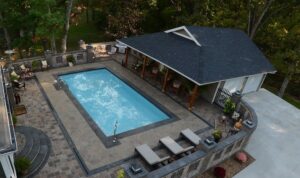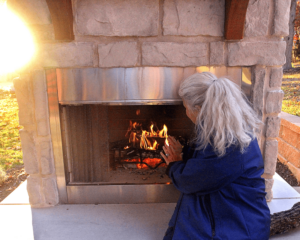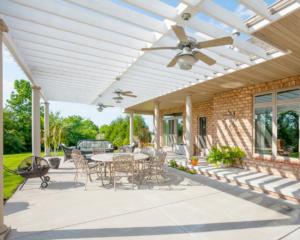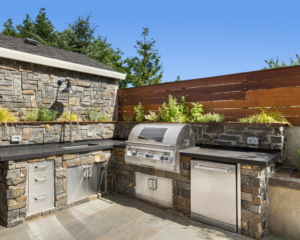Nestled in the heart of the Ozarks, Springfield, MO, boasts a unique blend of natural beauty and urban charm. But with this beauty comes certain geological and climatic challenges, especially when it comes to maintaining the integrity of our homes and landscapes.
One such challenge that many homeowners face is the issue of failing retaining walls. These walls, often taken for granted, play a crucial role in safeguarding our properties against soil erosion, water runoff, and landscape degradation. It’s essential for homeowners and homebuyers to understand the importance of retaining walls, the signs of their failure, and the steps to ensure their longevity.
If you’ve noticed issues with your retaining wall, keep reading. This guide aims to shed light on these aspects, helping you make informed decisions and maintain the safety and value of your property.
Why Do Retaining Walls Fail?
Retaining walls, like any other structure, have their vulnerabilities. Let’s delve into the common reasons behind the failure of retaining walls:
Natural Causes of Retaining Wall Failure
- Soil Pressure: Over time, the weight of the soil behind the wall can increase, especially if there’s a buildup of moisture. This added pressure can push against the wall, causing it to lean or even collapse.
- Water Accumulation: Inadequate drainage can lead to water pooling behind the wall. This not only increases soil pressure but can also weaken the materials of the wall itself.
- Freeze-Thaw Cycles: Our region’s winters can be unpredictable. When water trapped behind the wall freezes, it expands. Upon thawing, it contracts. This cycle can exert pressure on the wall, leading to cracks or shifts in its structure.
Southwest Missouri’s Unique Impact: The Ozarks region, with its hilly terrain and varied soil types, poses specific challenges. The natural slope of many properties can increase the pressure on retaining walls. Additionally, the region’s mix of clay and rocky soils can affect how water drains and how much pressure is exerted on these walls.

Man-made Causes of Retaining Wall Failure
- Poor Construction: A wall that isn’t built to the right specifications or without the proper foundation can fail prematurely. This includes inadequate depth, inadequate footing, improper materials, or lack of reinforcement.
- Lack of Proper Drainage: A retaining wall must have efficient drainage mechanisms, like weep holes or drainage pipes, to prevent water buildup. Failure to incorporate these can spell disaster for the wall’s longevity.
- Use of Subpar Materials: Not all materials are created equal. Using materials that aren’t suited for the specific soil or climatic conditions of the Ozarks can lead to early deterioration.
The Inevitable Impact of Time on Retaining Walls
No matter how impeccably a retaining wall is constructed, time remains an unyielding factor that can wear down even the sturdiest of structures. As the years roll on, various elements come into play that can affect the longevity of a retaining wall:
- Natural Wear and Tear: Just as roads wear out and buildings age, retaining walls too face the brunt of daily environmental stressors. From the beating sun to the pounding rain, these walls are constantly exposed to the elements, leading to gradual wear.
- Material Degradation: Over time, even the best materials, whether they be stone, brick, wood, or concrete, can degrade. This degradation can be accelerated by factors like moisture, pests (in the case of wooden walls), or chemical reactions within the materials.
- Ground Movement: The ground isn’t as static as we might think. Over the years, subtle shifts in the earth, often due to natural settling or even seismic activity, can impact the foundation of a retaining wall, leading to instability.
- Vegetation Growth: As time passes, roots from trees and shrubs can grow and push against the wall. While this might take years, the constant pressure from expanding roots can cause walls to crack or lean.
- Maintenance Lapses: Even the best-built walls require periodic maintenance. Over time, if small issues aren’t addressed, they can compound and lead to significant problems. For instance, a minor drainage issue left unchecked can, over the years, lead to significant water buildup and pressure.
- Design Life Expectancy: Every retaining wall, depending on its design and materials, has an expected lifespan. While some might last for decades, others, especially those built with less durable materials or temporary solutions, might have a shorter life expectancy.
For homeowners, understanding the impact of time on retaining walls is crucial. While it’s essential to build walls correctly from the outset, it’s equally important to recognize that, like all things, they have a finite lifespan. Regular inspections, timely maintenance, and an awareness of the wall’s age can help in timely interventions, ensuring safety and longevity.
Understanding these causes is the first step in prevention. By being aware of the potential pitfalls and ensuring that retaining walls are constructed and maintained with care, homeowners can safeguard their properties against the risks of wall failure. The next section will give you ideas on how to tell if your retaining wall is degrading.
Common Signs of a Failing Retaining Wall
Recognizing the early signs of a failing retaining wall can make all the difference between a simple repair and a costly replacement. Being proactive in spotting these signs can also prevent potential safety hazards. Here are some of the most common indicators that your retaining wall might be in distress:
- Tilting or Leaning Walls: One of the most evident signs of a problem is when the wall starts to lean or tilt away from the soil it’s supposed to retain. This can be due to increased soil pressure or foundational issues.
- Separation of the Retaining Wall from Adjoining Walls: If your retaining wall is part of a larger structure or is connected to other walls, any separation or widening gaps between them can indicate movement and instability.
- Crumbling or Cracked Masonry: Visible cracks, especially those that are widening over time, or crumbling sections of the wall can be signs of material degradation or excessive pressure.
- Soil Bulging Around the Base: If the soil appears to be pushing out or bulging at the base of the wall, it’s a clear sign that the wall is struggling to retain the earth behind it.
- Water Seepage: While some moisture can be expected, especially after heavy rains, consistent or excessive water seepage through the wall can indicate drainage problems. This not only weakens the wall but can also greatly increase soil pressure.
- Forward Movement or Slippage: If the wall appears to be moving forward or “slipping,” it’s a sign that the wall is failing to hold back the soil effectively.
- Erosion at the Wall Base: If you notice soil erosion around the base of the wall, especially after rain, it can indicate that water is not being drained away efficiently, undermining the wall’s foundation.
For residents of the Ozarks, with its unique terrain and weather patterns, it’s essential to be vigilant. Regularly inspecting your retaining wall, especially after significant weather events or seasonal changes, can help you catch these signs early. If you notice any of these indicators, it’s advisable to consult with a local expert to assess the severity of the issue and recommend appropriate solutions. Our Outdoor Inspections include a review of your retaining walls and provide options for repair or replacement.
What to Do If You Suspect Your Retaining Wall is Failing
Discovering signs of a failing retaining wall can be concerning for any homeowner. However, timely action can prevent further damage and ensure the safety of your property and loved ones. Here’s a step-by-step guide on what to do if you suspect issues with your retaining wall:
Prioritize Safety
- If the wall shows severe signs of distress, such as significant leaning or large cracks, keep family members and pets away from the area.
- Avoid placing any additional weight or pressure above the wall, such as parked vehicles or heavy equipment.
Document the Issue
- Take clear photographs of the problem areas. This not only helps in tracking the progression of the issue but can also be valuable when consulting with professionals.
- Make a note of when you first noticed the problem and any potential triggers, like heavy rainfall or construction activity nearby.
Consult with a Local Expert
Reach out to a local landscape company experienced in our local terrain and conditions. They can provide a thorough assessment of the situation. Contact Us
Avoid attempting DIY fixes without expert guidance, as this can sometimes exacerbate the problem.
Review Repair or Reconstruction Options
- Depending on the severity of the issue, the expert might suggest repairs, reinforcements, or, in more severe cases, a complete reconstruction.
- Ensure that any proposed solution addresses not just the visible symptoms but also the root cause of the failure. This might include adding weep holes, installing drainage pipes, or regrading the landscape to direct water away from the wall.
Stay Informed and Proactive
- After addressing the immediate issue, stay informed about the best practices for retaining wall maintenance.
- Have a quick look at your wall to notice any irregularities, especially after significant weather events, to ensure the continued health of your wall.
While the discovery of a failing retaining wall can be daunting, remember that with the right expertise and timely action, most issues can be effectively addressed. The key is to act quickly, consult with professionals, and prioritize the long-term health and safety of your property.
Frequently Asked Questions
As local retaining wall installers, we get lots of questions about retaining walls from homeowners and businesses in the area:
Q: How often should I inspect my retaining wall?
A: It’s advisable to conduct a visual inspection of your retaining wall at least twice a year, preferably during the spring and fall. Additionally, after significant weather events like heavy rains or freeze-thaw cycles, a quick check can help spot any immediate concerns.
Q: Are certain types of retaining walls more prone to failure in the Ozarks?
A: Different types of retaining walls have their strengths and weaknesses. Gravity walls and anchored walls tend to be more resilient. However, the key lies in proper construction and maintenance, regardless of the type.
Q: Can I repair a failing retaining wall myself?
A: While minor issues might be addressed with DIY solutions, it’s crucial to consult with experts for significant problems. Retaining walls require specialized knowledge, and DIY fixes can sometimes worsen the issue.
Q: How much does it cost to repair or replace a retaining wall?
A: Costs can vary based on the severity of the issue, the type of wall, and the materials used. While minor repairs might be relatively inexpensive, a complete reconstruction can be a significant investment. It’s best to get a detailed estimate.
Q: What’s the average lifespan of a retaining wall in the Ozarks?
A: Depending on the materials used and the quality of construction, a well-built retaining wall can last anywhere from 20 to 70 years. Regular maintenance can extend the lifespan of the wall.
Q: Is there a specific material recommended for retaining walls in our area?
A: Manufactured blocks and concrete are popular choices in the Ozarks due to their durability and resistance to the local climate and soil conditions. However, the best material often depends on the specific site and design requirements.
Q: How do I know if my retaining wall has adequate drainage?
A: Signs of inadequate drainage include constant water seepage, soil bulging, and erosion at the wall’s base.
Q: Are retaining walls mandatory for sloped properties?
A: While not always mandatory, retaining walls are highly recommended for significantly sloped properties to prevent soil erosion, manage water runoff, and provide usable land space.
Q: Can landscaping affect the health of my retaining wall?
A: Absolutely. Trees or shrubs planted too close to the wall can exert pressure through their root growth. Conversely, appropriate landscaping can aid in water management and enhance the wall’s longevity.
Q: Do local building codes in Springfield have specific requirements for retaining walls?
A: Yes, Springfield, like many cities, has building codes and regulations that pertain to the construction and maintenance of retaining walls, especially for walls of a certain height or those near public spaces. It’s essential to consult with local authorities or experts when planning or repairing a retaining wall.
Q: Why is my retaining wall separating?
A: Separation in a retaining wall can be caused by several factors. Increased soil pressure, inadequate construction, ground movement, or freeze-thaw cycles can lead to the wall moving away from its original position. It’s essential to consult with an expert to determine the exact cause and remedy.
Q: Are retaining walls load-bearing?
A: Walls can be built to handle both static and live loads. It’s always best to consult with an engineer.
Q: Why is my retaining wall sinking?
A: A sinking retaining wall can be a sign of foundational issues. This can result from inadequate footing depth or construction, poor soil compaction, or water erosion beneath the wall. Addressing this issue promptly is vital to prevent further complications.
Q: Should retaining walls leak?
A: While retaining walls should have mechanisms to drain water (like weep holes or drainage pipes) to prevent water buildup behind them, they shouldn’t continuously “leak.” If water is continuously seeping through the wall, it might indicate a drainage problem that needs addressing.
Q: Why are there permanent water marks on my retaining wall?
A: Permanent water marks, or efflorescence, are caused by water moving through the wall and bringing soluble salts to the surface. When the water evaporates, it leaves these salts behind as white, powdery marks. While they don’t compromise the wall’s structural integrity, they may be a sign of a larger drainage issue and should be evaluated.
Q: Can a leaning retaining wall be straightened?
A: It depends on the degree of the lean and the wall’s overall condition. Minor leans might be corrected with reinforcements, but significant leans often require partial or complete reconstruction. An expert assessment is crucial.
Q: How deep should a wall extend underground?
A: The wall should extend 1/8 of its total height underground. Below that, there should be a compacted stone footing. Always follow engineer recommendations.
Q: Is it normal for retaining walls to have cracks?
A: Small, hairline cracks might appear in retaining walls due to natural settling or minor ground movement. However, larger cracks or those that grow over time can indicate structural issues and should be addressed promptly.
_____
The rolling hills and picturesque landscapes of Springfield and the broader Ozarks region offer undeniable beauty, but they also present unique challenges for homeowners. Retaining walls, often the unsung heroes of our properties, play a pivotal role in ensuring the safety, aesthetics, and value of our homes. As we’ve explored, these walls, while robust, are not immune to the test of time, nature, and other external factors.
Being proactive, staying informed, and seeking expert advice are the cornerstones of ensuring the longevity and health of your retaining wall. Whether you’re a new homeowner, a long-time resident, or someone considering a move to the Ozarks, understanding the intricacies of retaining walls is invaluable.
At the heart of it all is the commitment to safeguarding our homes, our families, and the landscapes we cherish. By giving our retaining walls the attention and care they deserve, we not only protect our investments but also contribute to the enduring charm of our communities.



















